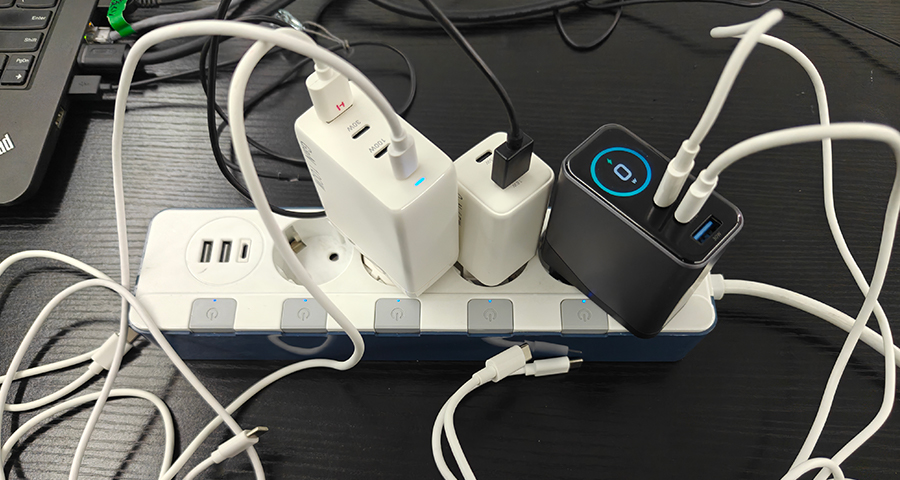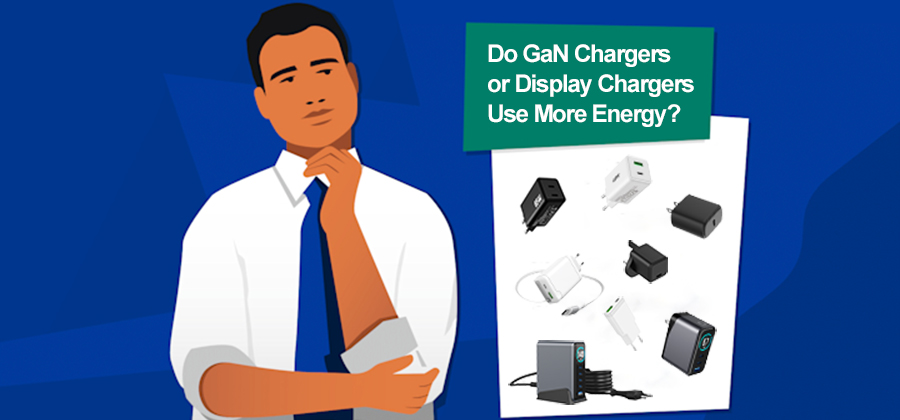🔌 Does a Charger Use Electricity When Not in Use?
You've probably wondered this at least once:
“If my phone charger is plugged in but not charging anything… is it still using electricity?”
Good news — today we’ll finally clear up the confusion.
And yes, we’ll talk about phone chargers, GaN chargers, PD chargers, and even display chargers (the ones with LED or digital screens).
Let’s dive in — without the boring textbook stuff.

🔋 1. So... Does a Charger Use Electricity When Not in Use?
✅ Short Answer:
Yes, a charger does use a small amount of electricity even when it’s plugged in and not charging a device — but the amount is extremely tiny.
This is called standby power or vampire power, and almost all electronics have it.
📌 Long Answer
Modern chargers — especially GaN chargers, USB-C PD chargers, and smartphone adapters — use only 0.1–0.3W of electricity when idle.
To put that into real numbers:
• Leaving a charger plugged in 24/7 for an entire year costs about $0.20–$0.60 in electricity.
• That’s less than the price of one cup of coffee per year.
So yes, chargers use electricity.
But no — it will not increase your electricity bill in any meaningful way.
⚙️ 2. Why Do Chargers Consume Power While Idle?
Even if you’re not charging a phone or laptop, your charger’s internal circuit stays partially active.
It needs a tiny amount of energy to:
1. Keep the voltage conversion stage alive.
2. Maintain safety functions (over-voltage, temperature monitoring).
3. Stay ready to detect when a device is plugged in.
This micro-power consumption is part of the design — and required for safe and stable charging.
✅ Short Answer:
Yes, a charger does use a small amount of electricity even when it’s plugged in and not charging a device — but the amount is extremely tiny.
This is called standby power or vampire power, and almost all electronics have it.
📌 Long Answer
Modern chargers — especially GaN chargers, USB-C PD chargers, and smartphone adapters — use only 0.1–0.3W of electricity when idle.
To put that into real numbers:
• Leaving a charger plugged in 24/7 for an entire year costs about $0.20–$0.60 in electricity.
• That’s less than the price of one cup of coffee per year.
So yes, chargers use electricity.
But no — it will not increase your electricity bill in any meaningful way.
⚙️ 2. Why Do Chargers Consume Power While Idle?
Even if you’re not charging a phone or laptop, your charger’s internal circuit stays partially active.
It needs a tiny amount of energy to:
1. Keep the voltage conversion stage alive.
2. Maintain safety functions (over-voltage, temperature monitoring).
3. Stay ready to detect when a device is plugged in.
This micro-power consumption is part of the design — and required for safe and stable charging.

🔥 3. Do GaN Chargers or Display Chargers Use More Energy?
⭐ GaN Chargers
GaN chargers are more efficient than traditional silicon chargers.
Their standby usage is even lower — usually 0.05–0.15W.
⭐ Display Chargers
Chargers with LED indicators or digital power displays use slightly more power due to the screen.
But still tiny — often under 0.3W.
So whether it's a:
• 65W GaN charger
• 30W USB-C charger
• Display charger with digital wattage meter
All of them use an extremely small amount of standby electricity.
⭐ GaN Chargers
GaN chargers are more efficient than traditional silicon chargers.
Their standby usage is even lower — usually 0.05–0.15W.
⭐ Display Chargers
Chargers with LED indicators or digital power displays use slightly more power due to the screen.
But still tiny — often under 0.3W.
So whether it's a:
• 65W GaN charger
• 30W USB-C charger
• Display charger with digital wattage meter
All of them use an extremely small amount of standby electricity.

🔌 4. Is It Safe to Keep a Charger Plugged In?
⭐ Safety Considerations
High-quality chargers (especially those with CE / RoHS / KC / ETL certifications) are safe to leave plugged in.
But cheap, uncertified chargers may:
• Overheat in standby
• Fail early
• Pose safety risks
So if you’re using a phone charger from a reliable manufacturer, you’re generally safe.
💡 5. Should You Unplug the Charger When Not in Use?
From an electricity bill perspective:
You don’t need to — because the cost is tiny.
From a safety perspective:
Unplugging helps reduce long-term heat exposure, especially with older wiring or low-quality chargers.
From a sustainability perspective:
Unplugging does reduce wasted energy on a global scale — even if only by a small amount.
So the best answer is:
You don’t have to, but it’s a good habit.
📉 6. How Much Electricity Does a Charger Waste? (Real Numbers)
As you can see - evena high-power 65W+ GaN charger uses less electirity on standby than a night light.
🔧 7. How to Reduce Standby Power from Chargers
Here are some practical tips:
• Use GaN chargers (highest efficiency).
• Avoid extremely cheap, non-certified chargers.
• Choose chargers with auto-sleep mode.
• Use a power strip with a switch.
• Unplug when traveling or during storms.
A: Yes, but only a tiny amount — usually 0.1–0.3W.
Q2: Do USB-C and PD chargers waste more power?
A: No. PD chargers are actually more efficient and use very low standby power.
Q3: Do GaN chargers use less electricity?
A: Yes. GaN chargers are the most energy-efficient on the market.
Q4: Does a charger get damaged if left plugged in all the time?
A: A high-quality charger will not. Cheap chargers may overheat or fail early.
Q5: Should I unplug my charger to save energy?
A: It’s optional — you’ll save only pennies per year — but it's better for safety and the environment.
🎯 Conclusion
So... does a charger use electricity when not in use?
Yes — but so little that most people wouldn’t even notice.
Modern PD chargers, GaN chargers, USB-C chargers, and display chargers consume extremely low standby power.
The cost is tiny, the safety level is high, and the efficiency keeps improving year by year.
But if you want to save maximum energy — or just keep your home safer — unplugging your charger is always a good habit.
High-quality chargers (especially those with CE / RoHS / KC / ETL certifications) are safe to leave plugged in.
But cheap, uncertified chargers may:
• Overheat in standby
• Fail early
• Pose safety risks
So if you’re using a phone charger from a reliable manufacturer, you’re generally safe.
💡 5. Should You Unplug the Charger When Not in Use?
From an electricity bill perspective:
You don’t need to — because the cost is tiny.
From a safety perspective:
Unplugging helps reduce long-term heat exposure, especially with older wiring or low-quality chargers.
From a sustainability perspective:
Unplugging does reduce wasted energy on a global scale — even if only by a small amount.
So the best answer is:
You don’t have to, but it’s a good habit.
📉 6. How Much Electricity Does a Charger Waste? (Real Numbers)
| Charger Type | Standby Power | Cost Per Year (24/7) |
| Standard 5V Phone Charger | 0.2W | $0.03/Year |
| 20W - 30W USB-C PD Charger | 0.15W - 0.25W | $0.20-0.60/Year |
| 65W Gan Charger | 0.05W - 0.15W | $0.15-0.30/Year |
| Display Charger | 0.2W - 0.3W | $0.30-0.70/Year |
🔧 7. How to Reduce Standby Power from Chargers
Here are some practical tips:
• Use GaN chargers (highest efficiency).
• Avoid extremely cheap, non-certified chargers.
• Choose chargers with auto-sleep mode.
• Use a power strip with a switch.
• Unplug when traveling or during storms.
❓ FAQ
Q1: Does a phone charger still use electricity when nothing is plugged in?A: Yes, but only a tiny amount — usually 0.1–0.3W.
Q2: Do USB-C and PD chargers waste more power?
A: No. PD chargers are actually more efficient and use very low standby power.
Q3: Do GaN chargers use less electricity?
A: Yes. GaN chargers are the most energy-efficient on the market.
Q4: Does a charger get damaged if left plugged in all the time?
A: A high-quality charger will not. Cheap chargers may overheat or fail early.
Q5: Should I unplug my charger to save energy?
A: It’s optional — you’ll save only pennies per year — but it's better for safety and the environment.
🎯 Conclusion
So... does a charger use electricity when not in use?
Yes — but so little that most people wouldn’t even notice.
Modern PD chargers, GaN chargers, USB-C chargers, and display chargers consume extremely low standby power.
The cost is tiny, the safety level is high, and the efficiency keeps improving year by year.
But if you want to save maximum energy — or just keep your home safer — unplugging your charger is always a good habit.